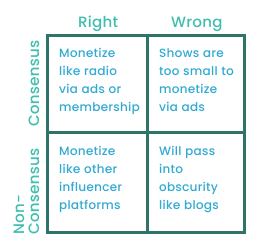On the “VC Fundamentals Part 2: Investment Decisions” episode of the Acquired podcast, hosts Ben and David had this exchange:
Ben, you mentioned right non-consensus bets versus right consensus bets. You can maybe start to see here that…
There is an incentive for anyone who wants to be promoted to make right consensus bets.
David: Right. Actually, pretty strong incentive not to make non-consensus bets. I think it was Howard Marks who coined this analogy and then Andy Rachleff popularized it. It may have been the other way around. If you think about investing as a 2x2 matrix, you can either make investments and be right about the investment, or you can be wrong about the investment. If you’re wrong, you’re just not going to make any money. Full stop.
But you actually have to be more than right to make real money, real outsize about market returns in investing. You need to be right and non-consensus. Because if you’re right and consensus, the market’s going to be right there with you, and you’re going to earn a relatively market return relative to the whole venture market. But if you’re able to do something that others aren’t and it’s right, that’s when you really make big returns.
[emphasis added]
That exchange hit me like a bolt of lightning. The phrase “non-consensus bet” struck me as precisely the hill I’ve been climbing since I began work on Intercast (then called TalkMobile, later called Signal) in 2010. This matrix immediately came to mind:
Having worked in the syndicated talk radio space, it was obvious to me in 2010 that podcasts were talk radio’s heir apparent, but that was not obvious to most people.
Following the above 2x2 matrix, over the past ten years, people have made the following bets about podcasts:
The wrong, non-consensus bet at that time was that podcasts would, like the rest of “new media” rise and fall into obscurity. It wasn’t a crazy thing to think: blogs and podcasts gained contemporaneously around 2005, but by 2010 the whole “citizen journalism” and “new media” revolution had failed to meaningfully usurp the influence and popularity of corporate media.
The wrong consensus bet at that time as that podcasts were a hobbyist industry and that audiences were too small to be meaningfully monetized. People who held that opinion (and many who still do) were on to something: massive monetization for podcasting won’t be found in a traditional, mass-media model.
The right consensus bet that was emerging at that time was that podcasts could be monetized just like radio shows using ads or by making them platform-exclusive. As I was building Signal in 2013, Midroll was launching and proving that podcasters could make money selling ads just like AM radio shows. Likewise, in 2020, Joe Rogan followed the road paved by Howard Stern, taking his show off of an open platform to a closed one (Stern moved from open AM to subscription-driven XM in 2006).
This brings us to my bet with Intercast.fm.
The future will prove that the right, non-consensus bet on podcasts is that they are a product for influencers speaking to micro-audiences and can best be monetized as such.
Those who said that podcasts were too small to meaningful monetize were almost right. Unlike the talk radio show I worked for in the early 2000’s, most podcasts will never monetize off of audiences of 2 million+ listeners. However, what these critics of podcasts failed to appreciate was how the internet was driving a powerful shift in our economy away from “mass market” toward “micro market.” A podcaster doesn’t need 2 million “listeners,” they could potentially make a great living off of only 100 true fans.
So how is this future going to be realized?
The podcast economy must change.
Podcasters must be given the same basic toolset influencers elsewhere on the internet have. The first of those basic tools are hyperlinks. Hyperlinks can take on a variety of forms in podcasts: affiliate links, buttons listeners can push to join email lists, links to social media platforms where listeners can follow a guest on a podcast, polls listeners can vote in, and more. Hyperlinks are the roads, bridges, and freeways of the internet, but they’re not a part of the core podcaster listener experience. Why?
At Intercast.fm, we’ve reimagined the consumption experience starting with the episode playback screen. Where competitors dedicate critical screen real estate to cover art, we’re dedicating this same space to a “prompt feed.” Podcasters will use this feed to drive engagement with their audiences. This engagement will be measurable and the metrics it will produce will be meaningful to both podcasters and their partners. Imprecise metrics like “downloads” will be replaced by much more useful metrics like “click throughs” and “conversions.”
This shift will unlock almost unimaginable possibility in the podcasting space. It will surface a heretofore hidden economy that I believe is in the hundreds of billions of dollars. Podcasters will finally get credit for business they are generating and they’ll be handsomely rewarded for it. Even the consensus bet people have made on advertising will prove to be more right as podcasters will be able to more precisely identify (and prove) the traffic they’re driving to advertisers.
There are more tools besides hyperlinks I’ve planned for Intercast.fm to roll out. However, the point of this essay is to focus on the nature of the non-consensus bet I’m making. Again, that bet is the best way to monetize podcasts is to remake the economy into one driven largely by influencers talking to micro-audiences where these influencers are deeply trusted and able to convert at 10x the rate of their mass-market, ad-driven counterparts.

